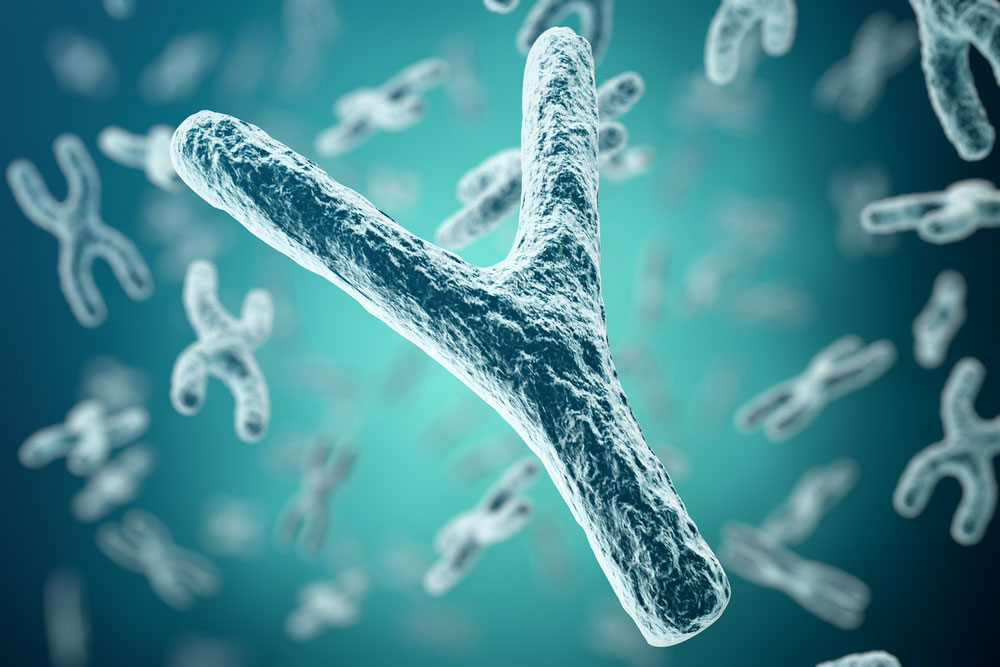Y- Chromosome Micro Deletion

Y- Chromosome Micro Deletion
As of late, the high recurrence of hereditary changes of the Y chromosome have been found in male fruitless patients. Y chromosome microdeletions have been widely examined due to the acknowledgment that Yq has factors significant for spermatogenesis: the azoospermia factor (AZF) district of the euchromatin long arm of the Y chromosome. Y chromosome microdeletions are clinically significant in light of the fact that they are related with serious male barrenness, and the probability of treatment achievement can be controlled by the area of the erasure. Microdeletions in the Y chromosome long arm (Yq) speak to the most regular sub-atomic hereditary reason for extreme barrenness, being recognized in 10%–15% of nonobstructive azoospermic and in 5%–10% of seriously oligozoospermic patients . In spite of the fact that the hereditary pathways and systems of spermatogenic weakness are still generally obscure, three areas, alluded to as "azoospermic factors" (AZFa, b and c from proximal to distal), have been distinguished on Yq , however various groupings have additionally been proposed . The AZF loci harbor 14 protein-coding qualities basic for spermatogenesis . Every one of these locales might be erased autonomously or in mix. The six exemplary types of AZF erasures and their relating phenotype, arranged by diminishing seriousness, include: AZFabc (SCO), AZFa (SCO), AZFbc (SCO/development capture), AZFb (development capture), AZFc (extreme oligospermia to azoospermia), and halfway AZFc (typical spermatogenesis to azoospermia) . The most regular microdeletion includes the AZFc locale (about 60%–70% of the erasures) and produces the loss of a few qualities. Various degrees of spermatogenetic modifications may be found however when all is said in done, most patients with this adjustment have sperm in the discharge or in the testicles. The AZFa district traverses 1100 kb, and harbors two protein-coding qualities: USP9Y and DBY . The DBY quality encodes RNA helicase and has been shown to assume a significant job in spermatogenesis . These cancellations are a direct result of intrachromosomal recombination between flanking rehashing hereditary groupings or palindromes. Complete erasures of AZFa are uncommon, representing just 3% of Y microdeletions. They convey the most unfortunate forecast with azoospermia in all men. Histology commonly shows SCO, with no past reports recognizing sperm with mTESE. In any case, incomplete AZFa cancellations have been accounted for; among these cases, USP9Y is erased in confinement. The clinical phenotypes were azoospermia and extreme oligospermia, with histology showing hypospermatogenesis . The AZFb area contains seven protein-encoding qualities tentatively demonstrated to be ensnared in spermatogenesis. These incorporate EIF1AY, RPS4Y2, and SMCY situated in the X-degenerate euchromatin, and HSFY, XKRY, PRY, and RBMY situated in the ampliconic locales. Erasures of the AZFb area are enormous (4.96e6.92 Mbs), and thought to be because of homologous recombination (HR) and nonhomologous recombination (NHR) among different instruments yet to be described . AZFb cancellations represent 15% of Y microdeletions. Constantly, complete erasures result in azoospermia and SCO or early development capture histology. The AZFc district traverses 4.5 Mb of euchromatin and contains five protein-encoding qualities demonstrated to be embroiled in spermatogenesis: BPY2, CDY, DAZ, CSPG4LY, and GOLGAZLY . The DAZ group of four qualities has been most productively considered. This family encodes RNA-restricting proteins communicated only in germ cells and exists in palindromic successions DAZ1/2 and DAZ3/4. Cancellations among this district are thought to happen through HR or NHR. Most every now and again, cancellations happen through HR and include ampliconic districts b2/b4, b1/b3, b2/b3, and gr/g, bringing about the erasure of a few qualities, including DAZ qualities. NHR represents erasures of ampliconic areas P3a, P3b, and P3c. AZFc cancellations are the most widely recognized Y microdeletions since this is made out of amplicons, which are especially helpless to erasures by the above techniques. AZFc cancellations represent 60% of all clinically important Y microdeletions . Up to 70% of men with AZFc cancellations have sperm in the discharge, commonly < 1 million sperm for every milliliter for these cryptospermic men with AZFc erasures. In men with azoospermia and AZFc cancellations, mTESE can be utilized to collect sperm from the gonad in half 60% of cases. Along these lines, richness potential is available in certain patients with AZFc erasures; in any case, Y microdeletions are passed to male posterity. Reports show that posterity with Y microdeletions commonly have debilitated spermatogenesis in light of the fact that their solitary wellspring of Y chromosome-related qualities is from the in part erased Y chromosome. Moreover, mixes of erasures in different AZF locales may happen. Consolidated AZFb e AZFc erasures are the most well-known on the grounds that the two locales cover and offer 1.5 Mb . These cancellations don't stretch out to a similar proximal degree as secluded AZFb erasures. In particular, CDY1 quality is made out of two duplicates; one duplicate exists in the AZFc locale while the other is in the zone of AZFb cover. This mix of erasures represents around 13% of Y microdeletions. Persistent phenotypes show SCO or development capture; sperm recovery endeavors are consistently ineffective. In rundown, Y microdeletions happen as often as possible and are shown among patients with azoospermia and serious oligospermia. Men with complete AZFa and b cancellations don't create sperm as far as we can tell, and fruitful careful sperm recovery has not been portrayed. Besides, AZFc cancellations are related with extreme oligospermia or azoospermia at introduction. These couples will probably require IVF-ICSI. Erasures of these districts are distinguished by sub-atomic methods, particularly PCR, following explicit guidelines . Y chromosome microdeletion examination isn't demonstrated when sperm fixation is above 5 million/mL. Craftsmanship strategies permit the transmission of Yq microdeletions, and male posterity of men with this hereditary modification will consequently additionally convey the cancellation and will have a weakness of spermatogenesis. Also, Yq microdeletions could deliver a higher level of sperm with sex chromosome aneuploidies . Hereditary directing ought to be given before helped proliferation as the Y microdeletion will be transmitted to the male posterity, with variable however antagonistic impacts on spermatogenesis.
.png)

